French First Week Activities:
In my previous 4 posts, I’ve talked about why it’s so important to create an immersion atmosphere, how to set the tone for the year, and how to set expectations for the first day of French class. In this post about the French first week activities, I’ll be sharing the lessons plans that I use, plus giving you some free resources to help you start your year off on the right track.
My last post left off halfway through the first day of teaching. We had just finished going over brief introductions, rules, how to ask to go to the bathroom, and expectations for target language use. Today, we’ll continue on with the curriculum that I use for immersion.
Lesson Plans
In French 1, I prefer to create my own curriculum and use the textbook as little as possible, only for practicing activities that I have taught or for homework. I find that most French 1-2 textbooks have too much English and aren’t based on how native speakers learn a language. Read more about that in “How Native Speakers Learn Differently than Language Learners“..
The First Week in French 1+2
Introductions: Start with one sentence the first day and add on each day. Here’s the progression that I use:
Day 1: Salut, je m’appelle _____________. Comment t’appelles-tu?
Day 2: + Enchanté/e. Au revoir.
Day 3: Ça va? Bien, très bien, comme çi, comme ça, pas très bien.
Day 4: Quel âge as-tu? J’ai _____ ans.
Day 5: Qu’est-ce que tu aimes faire? J’aime ______.
Day 6: Est-ce que tu voudrais étudier/danser/jouer au football avec moi? (start with étudier and teach them how to say other common verbs or activities that they like). Oui, j’aimerais bien ________ avec toi. Allons-y!
Day 7: Same as 6, but with . . . “Oui, je voudrais, mais je ne peux pas. J’ai besoin d’étudier.”
Day 8: Quel est ton numéro de téléphone? Mon numéro est . . .?
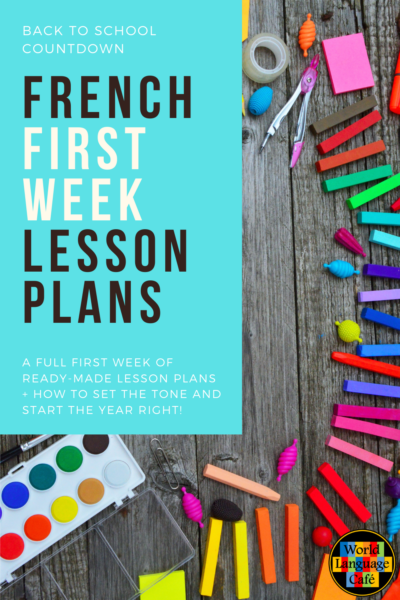
Now you may be thinking, “You’re teaching “voudrais” before teaching how to conjugate a regular verb? Yes, because this is how we naturally learn languages. Did you ever conjugate a verb when you were learning English? Nope! So don’t spend time doing this in class because all it does is train your students to think, “Hmm . . . how do I say that – let me go through the conjugation in my head”.
Instead, teach your students only the “I” and “you” forms for common conversations that happen every day. The majority of our daily conversations use these two forms. Think about the conversations that you have on a daily basis – most of them use “I” and “you”, right? That’s what students need most to be able to communicate. Read more about this technique here.
Nationality Partners
Have students fill out these free nationality partner sheets (a different partner for each nationality). You call out a nationality and they find someone in the room and say, “Hi, what’s your name?” and then write down the person’s name next to the nationality.
Whenever students need partners, in the target language, I call out a nationality, (ex. Canadian partners), and the students pair up with that partner. This helps them learn the countries, the nationalities, and work with a variety of students throughout the year. Grab these sheets now in my Free Resource Library.
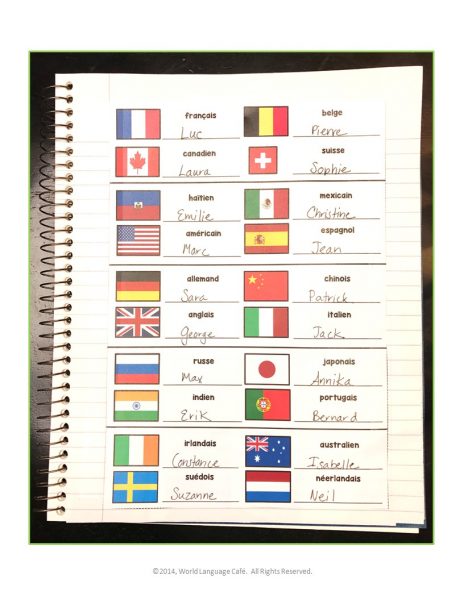
Numbers
For curriculum, whatever you begin with is up to you, but personally, I like to start with numbers since students will be using them to say how old they are very soon.
The key is to teach them and then have your students be able to recognize and say a number instantly. Being able to count is great, but you don’t want your students counting to figure out how to say 13. In partners have them roll a die and say the number out loud. Add another die and have them say the two numbers and the sum. Ex. 6+5=11 Use a page of only numbers and have them read the numbers out loud as they would read a paragraph.
- Free Number Reading Page available in my Free Resource Library
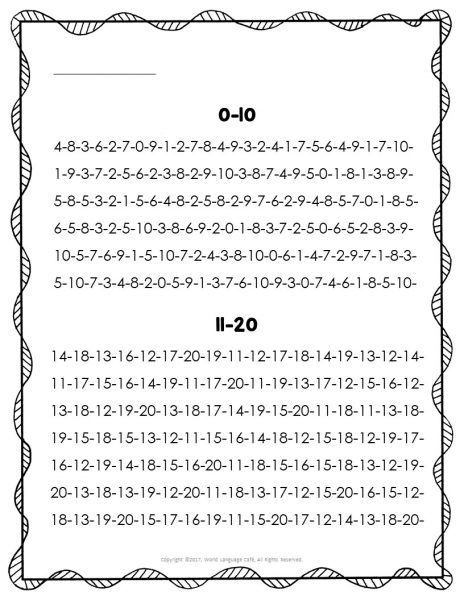
If you want more details about my step-by-step process for teaching numbers, check out these 2 additional blog posts on how to teach numbers.
Total Physical Response
Maybe it’s because I was a fidgety student (and still can’t sit still), but I love adding movement to my classes. Give instructions and have your students do them while you say them, “Stand up. Sit down. Walk to the board. Write your name. Take out your (pencil, paper, notebook). Repeat “______”, Give me your paper, give your paper to Pablo., etc.”. Be careful not to introduce too many at a time. Pick 3 or 4 to work on and add a few more each day. Limit this to 10-15 minutes a day.
Daily Schedule
Day 1: Class, stand up. Sit down. (Repeat several times). Walk. Run. Write your name. (Have the whole class do it, call on a few kids to do it, and call on individuals). Don’t ask for volunteers – just call on students randomly. That way they have to pay attention and they’ll know you’re no joke! Ask yes/no questions. Is Juan standing up? Running? Is he walking or running?
Day 2: (Add more detail). Stand up. Walk to the board. Write your name on the board. Walk to the window. Take out your pencil and paper. Who is this? What’s his/her name? Is this Carla or Sophia?
Day 3: I like to teach verbs early on because they are essential for communicating, so I throw in dance, sing, eat, drink. “Is Jack eating? What is he eating?” Answer the question with something funny – spaghetti – and model long strands of spaghetti and wrapping it around the spoon). Throw in crazy stuff. Is he eating pencils? (he pretends to be eating pencils). Is he eating spiders? (Draw a picture of a spider on the board). Pick your class comedian or a really active boy to act these out. The whole class will laugh and he’ll love being the center of attention.
At the end of your TPR sessions each day, test to see if students understand the new words by having them close their eyes. You say an action to see if they can do it. This will show you who is getting it, who isn’t, and what you need to review more.
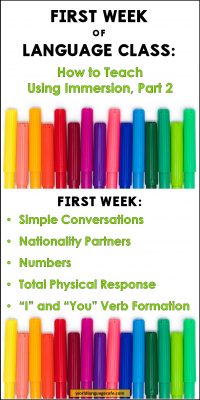
Communication in I and You Forms
Teach students 5-6 basic verbs (dance, eat, drink, sing, walk, run, write). After you have practiced the meanings with some TPR, ask simple questions and show how you cut off the ER and add “e” to say what you’re doing and “es” to ask what you’re doing. I use French interactive notebook flashcards to help practice this.
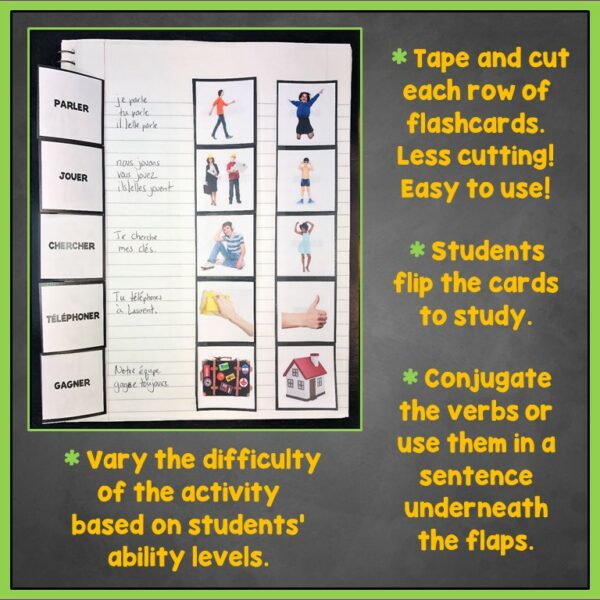
Ex. Are you dancing? Yes, I’m dancing. Are you eating? Yes, I’m eating.
Once they have mastered this teach negative responses, “No, I’m not dancing. I’m eating.”
First Week in Advanced Classes
In my advanced classes, I teach the same way as above but add more advanced activities such as:
- Interview the person next to you. Find out as many details as possible and then present this person to the class.
- Talk about what you did this summer. Other students ask follow-up questions.
- In partners, brainstorm why it’s important to learn French. Then have a discussion about this as a class.
- Have students make a list of stereotypes about the culture that they’re studying. Then lead a discussion as to why many of these stereotypes aren’t true. Add Francophone cultural videos throughout the year to show what life is really like in other countries.
- Students write interesting facts about themselves on a piece of paper and crumple it up into a ball. Then have a snowball fight. Students throw balled-up paper at each other. After 1-2 minutes, say, “Stop”. Students each pick up one paper, read it aloud and the individual or the class tries to guess who wrote it.
- Have students do a structured “Tout sur moi” presentation and writing assignment (free templates available in my Free Resource Library).
Whew! Guess I had a lot to say about the French first week activities.
Helpful Resources
Want to make your first week of school a whole lot easier so you can focus on getting to know your students? Check out my ready-made French first week lesson plans.
Everything you need to start the year off right including how to set the tone, step-by-step daily lesson plans, manipulatives, games, speaking activities, writing activities, cultural video clips and more!
Not sure how to decorate your French class? Check out these French classroom decor options:
Question Word Signs
Inspirational Posters
Classroom Labels
Francophone Countries Photos
Or get them all with the French Classroom Decor Bundle!

Stay tuned to my blog this year because I’ll be posting more about how to teach your students all in the target language. Remember to grab your 25+ free French lessons.
Happy Teaching!
~Sherry






2 Comments
Mercy
April 9, 2024 at 2:32 pmI love these ideas
Sherry Sebesta
September 12, 2024 at 8:37 amSo happy to hear that!